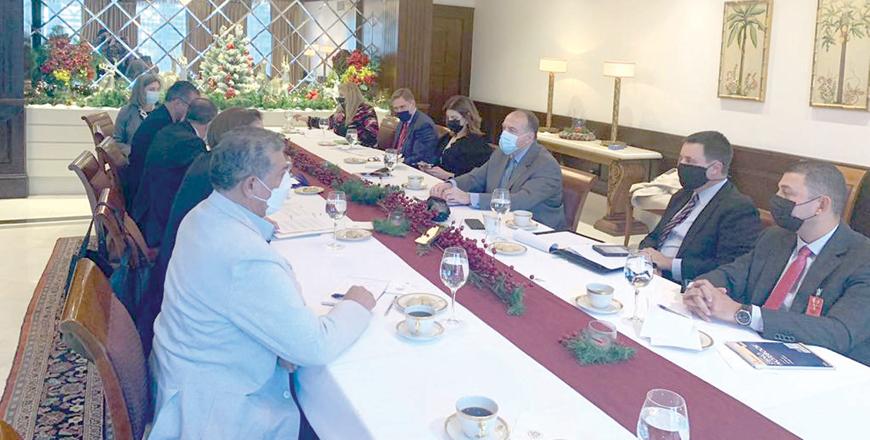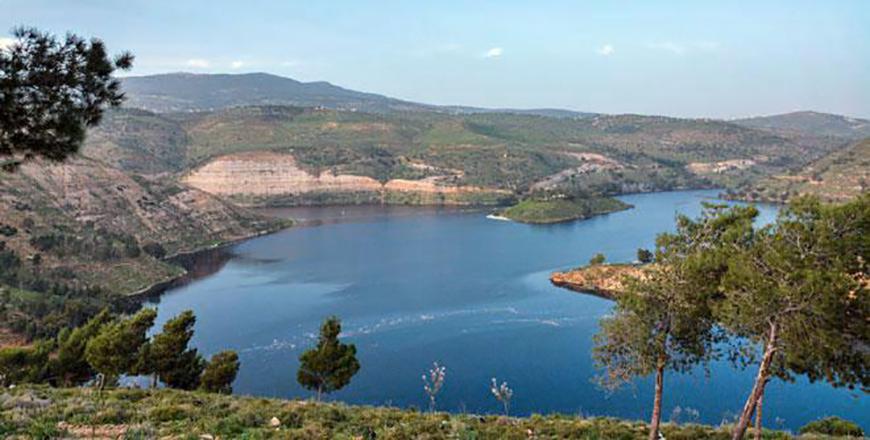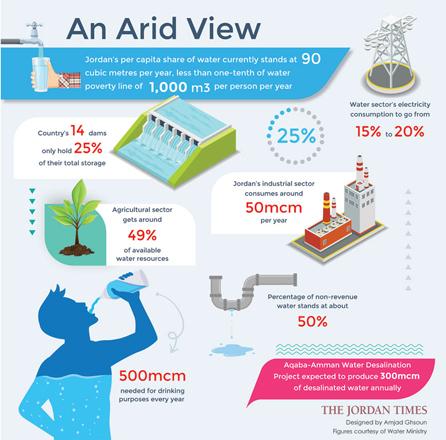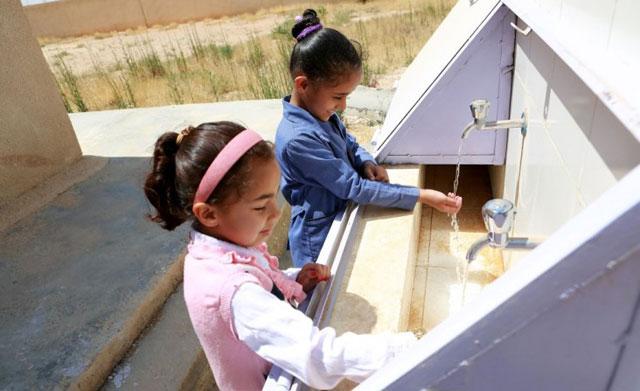You are here
Jordan’s 'serious' water scarcity requires immediate action — US ambassador
By JT - Dec 20,2021 - Last updated at Dec 20,2021

US Ambassador in Amman Henry T. Wooster speaks to media representatives in Amman on Sunday (Photo courtesy of US embassy)
- Remedying water shortage key to country’s stability, economy
- Stability of Jordan 'a paramount objective of US foreign policy'
- Diversification of water sources need of the hour
AMMAN — US ambassador to Jordan on Sunday said that addressing the Kingdom’s serious water supply shortage, which is a fundamental issue to the country’s stability and economy, is of key interest to Washington.
The US takes Jordan’s water scarcity “so seriously” as it is a matter of survival for the country and has a direct impact on the country’s three largest industries: Tourism, mining and textiles, which, with no consistent access to water, become imperiled, US Ambassador in Amman Henry T. Wooster told media representatives on Sunday.
Jordan, whose water sector runs at an extreme financial deficit at around $500 million per year and nearly half of its water supply is lost through thefts, inaccurate metering or leaks, needs to act immediately otherwise losses will widen.
“Jordan’s water scarcity requires immediate action… and anything that reinforces the stability of Jordan is a key interest for the US,” the ambassador said during the press meeting, attended by Sherry F. Carlin, the USAID Jordan Mission director.
Wooster stressed that “a paramount objective of the US foreign policy is the stability of Jordan”.
Regional integration has been a foreign policy objective for the US, he said, adding: “I want to be crystal clear, there is no voodoo conspiracy, it is not the illuminati or the masons or the CIA or whatever the conspiracy is. It is the foreign policy of the US for long time.”
In November, Jordan, the UAE and Israel signed a declaration of intent to negotiate the feasibility of a joint energy and water project under which Jordan could get 200 million cubic metres (mcm) of de-salinated water from Israel a year.
Under the deal, Jordan will export 600 megawatts of solar energy to Israel from a solar plant to be built in the Kingdom.
Indicating that water supply scarcity would constrain the country’s economy, the ambassador said it is in the interest of Jordan to diversify its water sources, which leads to more resilience.
“It is a smart action to take, as a matter of government policy, to explore every available option to meet the water needs,” he said.
The diversification of Jordan’s water sources includes conducting the Aqaba-Amman Water Desalination and Conveyance Project, the regional water agreements including the ones with Syria and Israel, projects to address the non-revenue water and water conservation, water pricing reforms, among others, Wooster said.
“It is our position that no one of any of these is the solution. It is not a mathematical equation where you pick the right variable and you solve the equation. Instead, it is a mixed menu and you need to allocate the resources to come up with which you need… There is on one single fix,” he said.
Raising the alarm about the seriousness of the water scarcity in Jordan, Carlin said: “When people ask us when will Jordan run out of water. Our answer is that it already has.”
Jordan is the third most water scarce country in the world with only two-thirds of the country’s water demands being met and bridging the gap will require more than $8 billion of new infrastructure over the next five to 10 years, Carlin said during the meeting.
She added that Jordan’s water sector runs at an extreme financial deficit at around $500 million per year.
For every JD1 users pay in the water bills, the government spends JD3 to extract, treat and deliver water to the households, she added.
“This deficit threatens the sector’s ability to pay for important repairs, perpetuating water losses in the water networks,” Carlin said.
She added that electricity is the water sector’s highest cost and subsidised water tariffs are insufficient to offset the cost of essential maintenance.
“If the government does not act now, it will lose an additional estimated $600 million per year once the Aqaba-Amman conveyance comes online,” she added.
The USAID Jordan mission director referred to the National Conveyance Project, saying once operational in 2027-2028, it will provide up to 40 per cent of Jordan’s water needs.
“Will the Aqaba-Amman conveyance project be expensive? Absolutely. Does Jordan have a choice, absolutely not,” Carlin said.
Highlighting the US support to Jordan in the water sector over the past seven decades, she reviewed projects supported by the US, adding that the US leveraged investments around $500 million by other donors, the private sector and the government of Jordan.
USAID is also actively working with the government to reduce water loss or non-revenues water, she said.
In 2020, non-revenue water losses reached $473 million, she said.
“It might be asked if so much money can be saved in water losses, why spend money on infrastructure... reality is that reducing non-revenue water takes time and large amounts of money,” she said.
She added that implementing an aggressive programme to address non-revenue water will only reduce losses by about 1-2 per cent per year.
“The government of Jordan is aiming to reduce non-revenue water to 35 per cent by 2040 but even if and when this ambitious goal is achieved there will still be supply gap of about 420mcm per year,” she said.
The USAID mission director said water use is already rationed in Jordan, which already overpumping water from its already depleted aquifers.
She added that ground water has been the basis of Jordan’s water security, saying: “People need to understand that ground water is being used twice as quickly as it can be replenished.”
“Jordan cannot waste a single drop of water. They must explore all available options to increase and diversify supply, improve efficiencies in managing the sector including increasing renewable energy use and reaching financial sustainability and reducing water losses,” she said.
The US has committed over $500 million to activities that support “each and every one of these areas”, she noted.
With the signing of the 1994 peace treaty, Jordan receives 35 million cubic metres (mcm) of water annually from Lake Tiberias, enough to supply the annual needs for 950,000 Jordanians.
In 2010, Jordan began making additional emergency water purchases with an average increase of 8mcm per year to help cover the chronic water shortages and meet the needs of additional 220,000 people.
In July this year, Jordan and Israel took a major step in water cooperation and with the COVID-19 pandemic, households’ consumption has increased. Jordan was hit by a rainfall shortage. Jordan bought additional 50mcm from Israel, which helped Jordan meet 25 per cent of its water supply gap, bringing water currently to 1.3 million Jordanians per year.
Carlin said USAID is building a new pipeline to pump the additional water quantities from Israel to Jordan.
The 7 kilometre pipeline will have an annual capacity of 80mcm per year and construction of the new pipeline will be completed within 12 to 18 months.
The pipeline is partially funded by USAID in addition to the Jordanian government.
Currently, another pipeline with an annual capacity of 50mcm is pumping water from Israel to Jordan and the new pipeline will help reduce the pressure on the old pipeline.
She added that the USAID is working on water conservation, saying more than 50 per cent of Jordan’s water is consumed by the agriculture sector, which only contributes 4 per cent to GDP.
Studies have shown that farmers often use two-five times more water than needed and by working with the private sector, USAID is encouraging the adoption of new technologies and best practices, Carlin said.
“Over the last five years, we have seen a total savings of 22.8mcm of water. This is enough water to supply the needs of 624,000 people per year,” she noted.
“US will continue to stand by Jordan and people of Jordan to make the water sector more resilient and secure,” she added.
Related Articles
AMMAN — The United States Agency for International Development (USAID) on Sunday announced a project to build a new pipeline to pump additio
AMMAN — The negative impacts of climate change are snowballing, taking a heavy toll on Jordan’s water sector as the government warns that this year is the most difficult the sector has seen.
AMMAN — The Ministry of Water and Irrigation on Wednesday announced the launch of the Aqaba-Amman Water Desalination and Conveyance National
















